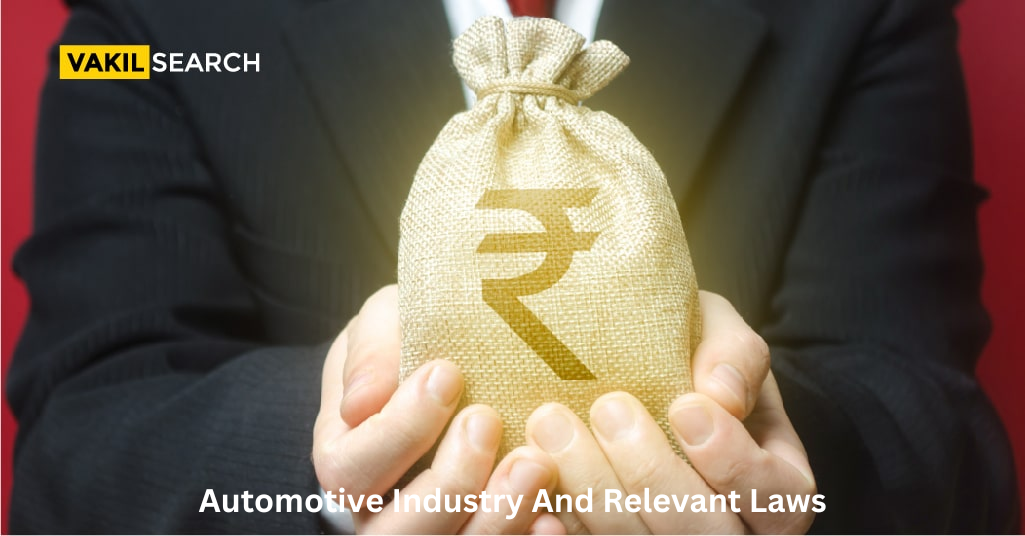The Indian auto industry is expected to enter a significant growth phase. Since research into much more effective electric vehicles & biofuels is being carried out at a tremendous pace, the potential of alternative-fuel vehicles has not yet been fully explored but holds incredible potential. In this article let’s deeply find the details about the automotive industry & relevant laws.
Automotive Industry
The horseless carriage was invented by hundreds of manufacturers before the automotive industry was founded in the 1860s. The United States dominated global auto production for many years. Before the Great Depression, in 1929, there were 32,028,500 automobiles in use worldwide, with more than 90% of them coming from the United States. America had one car per 4.87 people at that time. About 75% of the world’s largest auto production occurred after 1945 in the United States. Japan overtook the U.S. in 1980, and the U.S. regained the top spot in the world in 1994. In terms of production, Japan narrowly surpassed the United States in 2006 and held this lead until 2009, when China passed Japan with 13.8 million units. China produced 19.3 million units in 2012, almost twice as many as the United States, which produced 10.3 million, with Japan coming in third with 9.9 million. In the United States, there are now exponentially more car models than there were in 1970 (140 models), 1998 (260 models), and 2012. (684 models).
Automobile Law
With a goal of “emerging as the preferred destination in the world for design and production of automobiles and auto components with output achieving a level of US$ 145 billion taking account for even more than 10% of the GDP and providing extra employment to 25 million people by 2016,” India’s Automotive Mission Plan 2006-2016, a joint initiative between the Indian Government, the Automotive Industry, and the Academic Community, was created in 2006. The government’s forward-thinking actions and the stakeholders in the industry’s active participation can guarantee the development of the ideal environment for this sector’s rapid growth.
One of the quickest increasing manufacturing sectors inside the nation is the Indian Automotive Industry, which consists of the automobile and auto component sections. Automobile, truck, bus, construction machinery, and automotive component manufacturing and distribution have evolved into multifaceted global business operations.
You no longer need to worry about coming up with a Company Name. To get a list of available firms, use Vakilsearch’s company name generator.
Significant Industry Trends:
- The Indian automotive industry has a lot of potential in the relatively untapped rural market
- Price point, fuel economy, and the use of alternative fuels are factors that stimulate growth (like electric cars, etc.)
- With the exception of China, India’s automobile market is quite unique in that the majority of demand is for two-wheelers (almost 75%)
- Large-scale acquisitions like the one of Tata-JLR can increase choice for Indian consumers while bringing Indian expertise in supply-chain efficiency to foreign manufacturers
- The government’s increased spending on public transportation, which is a result of the deteriorating road infrastructure in most major Indian cities, is expected to cause the commercial vehicle category to experience significant growth over the next 10 years.
Industry Trends for Growth:
- In comparison to other major auto markets, India’s auto market is unique in that two-wheeler demand makes up 80% of the total market
- Additionally, factors like affordability, fuel efficiency, and the use of alternative fuels promote growth
- The Indian automotive industry has a lot of potential in the relatively untapped rural market
- Large-scale acquisitions can also help India improve the effectiveness of its supply chains, lower production costs for foreign manufacturers, and give Indian consumers more options
- Commercial vehicle prices are expected to rise significantly over the next few decades as a result of increased government spending on public transportation, which is a response to the deteriorating road infrastructure in the majority of India’s major cities.
How to Start an Automobile Industry in India
- Research is the first step in starting any car accessory business, or you can purchase a franchise from an established accessories brand that has a solid track and cord, a solid reputation, is very well, and is also current with market requirements
- Choose how you want to open a physical store or an online store
- Well, having an online store is less expensive because the overall cost is lower, but your profits here will be very low
- Finally, pick a niche. In a business like this, there are numerous rivals.
Among the most promising suppliers of automotive accessories are:
- Elegant Auto Retail
- Elite industries
- Auto Craft
- Bombay Motor Accessories
- Cars park
Therefore, differentiation is necessary for your company to stand out from the competition. Numerous automobile accessories, such as
- Car covers
- Car sander
- Increaser Cable
- Seat hooded cloaks/ covers
- Mobile Supporter
- Puncture-fixing toolkit
- Pressure gauge and tyre inflator.
- Using GPS devices
- A complete toolbox
- Cleaning supplies
- Auto mats
- Sun shades for the windshield
It is much simpler to establish themselves as a go-to place for a specific type of accessory than for accessories generally, so the most approachable approach would be to focus on one particular segment instead of trying to cater to everyone, such as premium car accessories, seat covers, etc.
- Analyze your rivals before choosing a location. If you believe there is a lot of competition at the chosen location, change your plans.
- Finally, if you still have money left over, use it wisely to advertise because it could boost your sales.
- Promote your business online or through paid media in locations where you anticipate finding your customers, such as auto magazines and websites.
Regulatory Laws
-
Motor Vehicles Act, 1988
The MVA vests authority with the central and state governments to make and implement rules regulating the construction, equipment, and maintenance of automobiles with respect to several aspects including dimensions, emission norms, automobile parts such as brakes, steering gears, safety devices, and warranty after-sales. Moreover, the central government primarily administers and regulates the industry through its apex wing, the Ministry of Road Transport and Highways.
Insurance of an automobile is compulsory before the automobile can be driven in a public place. Additionally, insurance of an automobile is provided by an authorised insurer, which issues a certificate to the policyholder. Further, an insurance policy is usually valid for one year and is required to be renewed before the due date. The MVA mandatorily requires the insurance policy to cover third-party risks.
-
Central Motor Vehicle Rules, 1989
The manufacturing and maintenance of an automobile must comply with the parameters and standards as prescribed under the CMV Rules and those notified by the central government from time to time. Further, a manufacturer or importer that proposes to manufacture or import a new automobile is required to obtain approval of the prototype of such an automobile from the designated testing agencies. The procedure for type approval and certification of automobiles for compliance with the MVA and CMV Rules should accord with the Automobile Industry Standards as prescribed and notified by the central government. Additionally, while the production of automobiles is ongoing, the CMV Rules require conformity of production. Moreover, these tests are to be conducted periodically on automobiles drawn from the production line to verify that they conform to the approval certification. Upon manufacturing being completed and the sale of an automobile, the manufacturer has to issue a certificate of roadworthiness. Further, quality to the owner, and thereafter, for in-use vehicles, owners are required to obtain a pollution under control (PUC) certificate a year after the date of its registration.
Taxation laws
-
Income Tax Act, 1961: Transfer Pricing Regulations
The Income Tax Act has provisions that make provisions for the taxation of income arising from transactions between associated enterprises. Further, Transfer Pricing Regulations lay down that any income arising from such an “international transaction” shall be computed having regard to the “arm’s length price”. Likewise, the regulation also lays down the method to calculate the Income tax. Further, as is already discussed above that the Automotive Sector in India is one of the largest in the world. Additionally, producing almost 20 million units a year, the industry is often subjected to rigorous transfer pricing scrutiny; which may lead to slower growth in the Automotive Sector.
-
Custom Duty
Customs duty is charged when any product is imported to India. Moreover, automobile manufacturers based in foreign countries who want to avail of lower custom duties. Additionally, pass on the benefits to the customers can import Completely Knocked Down Kits (CKD) Kits which are charged concessional Customs duty.
| Criteria / Applicability | Import Duty in % |
| Used car import | 125 |
|
Cars CBUs whose CIF value is more than $ 40,000 or Petrol Engine > 3000 CC or Diesel engine > 2500 CC |
100 |
|
Cars CBUs whose CIF value is less than $ 40,000 and Petrol Engine < 3000 CC and Diesel engine < 2500 CC |
60 |
| Two-wheeler CBUs | 50 |
| Commercial Vehicle CBUs (Trucks & Buses) | 30 |
| CKD containing engine or gearbox or transmission mechanism in pre-assembled form but not mounted on a chassis or a body assembly (Passenger Vehicles) | 30 |
| CKD containing engine or gearbox or transmission mechanism in pre-assembled form but not mounted on a chassis or a body assembly (Two-wheelers) | 25 |
| CKD containing engine or gearbox or transmission mechanism in pre-assembled form but not mounted on a chassis or a body assembly (Commercial Vehicles) | 25 |
| CKD containing engine, gearbox, and transmission mechanism, not in a pre-assembled condition | 15 |
Environment and Safety Regulations
Environment Protection Act, read with Environment (Protection) Rules 1986
The MVA read with the CMV Rules authorises the central government to notify, from time to time- Quality, Safety, and Performance Standards, the standards about any part, component, or assembly to be used in the manufacture of an automobile.
Every manufacturer is required to obtain the prototype of the part, component, or assembly for which standards have been notified and approved by any agency referred to in rule 126 of the CMV Rules. Likewise, after obtaining approval, every manufacturer shall also certify compliance with the statutory form prescribed under the CMV Rules.
Additionally, the Ministry of Environment and Forests has laid down rules to ensure that standards for emissions of air pollutants from automobiles are kept in consonance with international standards.
Schedule IV of the Environment (Protection) Rules 1986 provides for standards for emissions of smoke, vapour, etc, from automobiles. Moreover, the Bharat Stage Emission Standards (based on European regulations) are emission standards. Likewise, this has been set up by the central government to regulate air pollutants from internal combustion engine equipment, including motor vehicles. Currently, the vehicle emissions standards adopted throughout the country are the Bharat Stage IV or BS-IV. Additionally, the MVA requires every automobile owner to carry a valid PUC certificate; Further, which is issued by the designated checking facilities to certify compliance with the prescribed emission norms. The current emission standards applicable in India are due to be updated very shortly; with the Ministry of Road Transportation and Highways; amending the CMV Rules to mandatorily require every vehicle manufactured on or after 1 April 2019 to be compliant with the new Bharat Stage VI (BS-VI) emission standard. Additionally, the MVA prescribes punishment by way of a fine in the event a person is found to be driving an automobile in any public place that violates the standards prescribed about any road safety and pollution.
Competition regulations
Competition Act, 2002
The Competition Commission of India (CCI) (the authority regulating competition in India) actively investigates allegations of anti-competitive behaviour in the automotive sector. Moreover, the CCI observed that owing to technical specifications of the cars manufactured by; each original equipment manufacturer (OEM), the spare parts of one brand cannot be used for the repair and maintenance of cars manufactured by another OEM. Moreover, since the spare parts of one OEM are not interchangeable with those of other OEMs, each OEM is shielded. Additionally, shield the competition in the aftermarket from the existing competitors in the primary market.
Moreover, each OEM holds a position of strength, which enables it to affect its competitors in the secondary market. Thereby, limiting consumer choice and compelling consumers to behave in a manner beneficial to the OEMs. Additionally, this allows them to enjoy a dominant position and strength in the aftermarket for spare parts.
The agreements entered into by OEMs with their original equipment suppliers (OESs); authorised dealers to prohibit the sale of spare parts to independent repairers in the secondary market. Further, the CCI was of the view that each OEM holds a position of strength. Further, this enables it to affect its competitors in the secondary market or aftermarket. Thereby, limiting consumer choice and compelling consumers to behave in a manner beneficial to the OEMs. Similarly, which allows them to enjoy a dominant position and strength in the aftermarket for spare parts.
Top 10 Trends in the Automotive Industry
-
Autonomous Vehicles (AVs)
Autonomous or self-driving cars reduce the need for human drivers and appear set to revolutionise daily transportation. Fleets of AVs aim to make public transportation somewhat safer, increase the range of last-mile delivery services, and decrease downtime.
-
Connectivity of Vehicles and Electrification
Today’s vehicles are identified from other vehicles in the network by a tamper-proof digital identity. This makes it simple to track vehicle data for a variety of applications, including fleet management, insurance, driver safety, and predictive maintenance. Sharing vehicle data improves the entire mobility ecosystem, not just the individual customer.
-
Electrification
The need to encourage the use of electric mobility solutions is driven by the depleting fossil fuel reserves and the harm that their use causes to the environment. EVs must address problems like high cost, bad battery, inadequate charging infrastructure, fleet electrification, and powering renewable energy-based charging grids if they are to be adopted more widely. Startups are developing electrification solutions in response to these issues as well as the requirement to address the rising greenhouse gas emissions worldwide.
-
Shared Mobility
New business models that emphasise shared mobility as an alternative to traditional vehicle ownership have emerged as a result of connected vehicles. As a result, unused vehicles are discouraged and mobility-as-a-service (MaaS) is enabled. Without purchasing additional vehicles, these solutions satisfy the needs of a city or a company, reducing fleet wait times and pollution from gasoline or diesel vehicles.
-
Artificial intelligence
Robotic automation in the automotive sector uses artificial intelligence technologies like computer vision, deep learning, and machine learning. These direct autonomous vehicles, oversee fleets, help drivers be safer, and enhance services like vehicle inspection and insurance. AI is also used in the production of automobiles, where it lowers costs and speeds up production.
-
Analytics & Big Data
Throughout a vehicle’s lifecycle, decisions are made using big data and advanced analytics. Vehicle data allows predictive maintenance, provides managers with fleet information and notifies relevant authorities in the event of an accident. Additionally, customer automotive data has used for boosting sales, streamlining supply chains, and improving product design for more recent vehicles. Startups and new businesses create big data solutions to assist automakers and related sectors in streamlining their operations to increase margins.
-
Human-Machine Interfaces
Drivers’ interactions with their vehicles will fundamentally change as self-driving and connected cars change the automotive industry. Vehicle control systems employ voice- or haptic-based human-machine interfaces. These broaden the range of car-related functions that users can control. As a result, these interfaces improve the safety and fun of driving. Smart virtual assistants that assist users in interacting with vehicles, as well as other service providers, are another type of HMI.
-
Blockchain
Numerous automotive applications are made possible by blockchain. For connectivity and shared mobility solutions like ride-hailing, urban transportation, and deliveries, these include being able to share vehicle data over a secure network. Blockchain can also be used to ensure that raw materials and spare parts are only sourced from legitimate and reputable sources, or to authenticate the supply chain of replacement parts.
-
3D Printing
The automotive sector benefits from 3D printing in three main ways. First off, it facilitates rapid prototyping with 3D printed models that quicken the production design and testing phases. Second, it enables manufacturers to print replacement parts that exactly fit their needs. Last but not least, composite material additive manufacturing produces lighter, tougher, and longer-lasting automotive parts.
-
Internet of Things
IoT makes it possible for vehicles and infrastructure components as well as between vehicles to communicate securely in the automotive sector. With better fleet management, the technology raises road safety, eases traffic, and lowers pollution and energy use. Startups and emerging businesses create sophisticated sensing technologies to learn more about vehicles and give them the ability to comprehend their surroundings. Additionally, fuel and toll payments are automated by technology.
Conclusion
Only a small portion of the automotive trends we discovered during our extensive research are covered in the Automotive Industry Trends & Startups section of this report. Hybrid cars, robots, and automotive sensor technologies, among many others, will change the industry that makes up it today. Gaining a competitive advantage requires early adoption of new opportunities and emerging technologies in your business. Get in touch with us to quickly and thoroughly research the startups and technologies that are important to you.
if you wish to talk to a lawyer or are facing any other legal issue and want to have legal consultations with the empaneled lawyers at Vakilsearch, call our helpline at +91 7200 365 365.
Also, Read:










